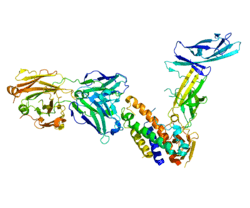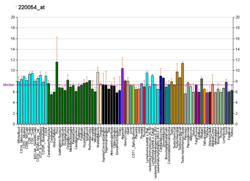Interleukin 23 subunit alpha
Interleukin-23 subunit alpha is a protein that in humans is encoded by the IL23A gene.[5][6] IL-23 is produced by dendritic cells and macrophages.
Interleukin-23 is a heterodimeric cytokine composed of an IL-12p40 subunit that is shared with IL-12 and the IL-23p19 subunit.[5] A functional receptor for IL-23 (the IL-23 receptor) has been identified and is composed of IL-12R β1 and IL-23R.[7]
Function
IL-23 is an important part of the inflammatory response against infection. It promotes upregulation of the matrix metalloprotease MMP9, increases angiogenesis and reduces CD8+ T-cell infiltration into tumours. IL-23 mediates its effects on both innate and adaptive arms of the immune system that express the IL-23 receptor. Th17 cells represent the most prominent T cell subset that responds to IL-23, although IL-23 has been implicated in inhibiting the development of regulatory T cell development in the intestine. Th17 cells produce IL-17, a proinflammatory cytokine that enhances T cell priming and stimulates the production of other proinflammatory molecules such as IL-1, IL-6, TNF-alpha, NOS-2, and chemokines resulting in inflammation.
The expression of IL23A is decreased after AHR knockdown in THP-1 cells and primary mouse macrophages.[8]
Clinical significance
Knockout mice deficient in either p40 or p19, or in either subunit of the IL-23 receptor (IL-23R and IL12R-β1) develop less severe symptoms of experimental autoimmune encephalomyelitis (EAE) and inflammatory bowel disease highlighting the importance of IL-23 in the inflammatory pathway.[9][10]
Discovery
A computational search for IL-12 homologue genes found p19, a gene that encodes a cytokine chain. Experimental work revealed that p19 formed a heterodimer by binding to p40, a subunit of IL-12. This new heterodimer was named IL-23.[11]
Knockdown of AHR decreases the expression of IL23A in THP-1 cells and primary macrophage.[8]
See also
- Ustekinumab, a monoclonal antibody targeting both IL-12 and IL-23 and used to treat plaque psoriasis, launched in the United States under the brand name Stelara
References
- 1 2 3 GRCh38: Ensembl release 89: ENSG00000110944 - Ensembl, May 2017
- 1 2 3 GRCm38: Ensembl release 89: ENSMUSG00000025383 - Ensembl, May 2017
- ↑ "Human PubMed Reference:".
- ↑ "Mouse PubMed Reference:".
- 1 2 Oppmann B, Lesley R, Blom B, Timans JC, Xu Y, Hunte B, et al. (November 2000). "Novel p19 protein engages IL-12p40 to form a cytokine, IL-23, with biological activities similar as well as distinct from IL-12". Immunity. 13 (5): 715–25. doi:10.1016/S1074-7613(00)00070-4. PMID 11114383.
- ↑ "Entrez Gene: IL23A interleukin 23, alpha subunit p19".
- ↑ Parham C, Chirica M, Timans J, Vaisberg E, Travis M, Cheung J, et al. (June 2002). "A receptor for the heterodimeric cytokine IL-23 is composed of IL-12Rbeta1 and a novel cytokine receptor subunit, IL-23R". Journal of Immunology. 168 (11): 5699–708. doi:10.4049/jimmunol.168.11.5699. PMID 12023369.
- 1 2 Memari B, Bouttier M, Dimitrov V, Ouellette M, Behr MA, Fritz JH, White JH (November 2015). "Engagement of the Aryl Hydrocarbon Receptor in Mycobacterium tuberculosis-Infected Macrophages Has Pleiotropic Effects on Innate Immune Signaling". Journal of Immunology. 195 (9): 4479–91. doi:10.4049/jimmunol.1501141. PMID 26416282.
- ↑ Langowski JL, Zhang X, Wu L, Mattson JD, Chen T, Smith K, Basham B, McClanahan T, Kastelein RA, Oft M (July 2006). "IL-23 promotes tumour incidence and growth". Nature. 442 (7101): 461–5. doi:10.1038/nature04808. PMID 16688182.
- ↑ Kikly K, Liu L, Na S, Sedgwick JD (December 2006). "The IL-23/Th(17) axis: therapeutic targets for autoimmune inflammation". Current Opinion in Immunology. 18 (6): 670–5. doi:10.1016/j.coi.2006.09.008. PMID 17010592.
- ↑ Korn T, Bettelli E, Oukka M, Kuchroo VK (2009). "IL-17 and Th17 Cells". Annual Review of Immunology. 27: 485–517. doi:10.1146/annurev.immunol.021908.132710. PMID 19132915.
Further reading
- Lankford CS, Frucht DM (January 2003). "A unique role for IL-23 in promoting cellular immunity". Journal of Leukocyte Biology. 73 (1): 49–56. doi:10.1189/jlb.0602326. PMID 12525561.
- van de Vosse E, Lichtenauer-Kaligis EG, van Dissel JT, Ottenhoff TH (March 2003). "Genetic variations in the interleukin-12/interleukin-23 receptor (beta1) chain, and implications for IL-12 and IL-23 receptor structure and function". Immunogenetics. 54 (12): 817–29. doi:10.1007/s00251-002-0534-9. PMID 12671732.
- Kreymborg K, Böhlmann U, Becher B (December 2005). "IL-23: changing the verdict on IL-12 function in inflammation and autoimmunity". Expert Opinion on Therapeutic Targets. 9 (6): 1123–36. doi:10.1517/14728222.9.6.1123. PMID 16300465.
- Peluso I, Pallone F, Monteleone G (September 2006). "Interleukin-12 and Th1 immune response in Crohn's disease: pathogenetic relevance and therapeutic implication". World Journal of Gastroenterology. 12 (35): 5606–10. doi:10.3748/wjg.v12.i35.5606. PMID 17007011.
- Prashar Y, Weissman SM (January 1996). "Analysis of differential gene expression by display of 3' end restriction fragments of cDNAs". Proceedings of the National Academy of Sciences of the United States of America. 93 (2): 659–63. doi:10.1073/pnas.93.2.659. PMC 40108. PMID 8570611.
- Wiekowski MT, Leach MW, Evans EW, Sullivan L, Chen SC, Vassileva G, Bazan JF, Gorman DM, Kastelein RA, Narula S, Lira SA (June 2001). "Ubiquitous transgenic expression of the IL-23 subunit p19 induces multiorgan inflammation, runting, infertility, and premature death". Journal of Immunology. 166 (12): 7563–70. doi:10.4049/jimmunol.166.12.7563. PMID 11390512.
- Broberg EK, Setälä N, Erälinna JP, Salmi AA, Röyttä M, Hukkanen V (June 2002). "Herpes simplex virus type 1 infection induces upregulation of interleukin-23 (p19) mRNA expression in trigeminal ganglia of BALB/c mice". Journal of Interferon & Cytokine Research. 22 (6): 641–51. doi:10.1089/10799900260100123. PMID 12162874.
- Pirhonen J, Matikainen S, Julkunen I (November 2002). "Regulation of virus-induced IL-12 and IL-23 expression in human macrophages". Journal of Immunology. 169 (10): 5673–8. doi:10.4049/jimmunol.169.10.5673. PMID 12421946.
- Lo CH, Lee SC, Wu PY, Pan WY, Su J, Cheng CW, Roffler SR, Chiang BL, Lee CN, Wu CW, Tao MH (July 2003). "Antitumor and antimetastatic activity of IL-23". Journal of Immunology. 171 (2): 600–7. doi:10.4049/jimmunol.171.2.600. PMID 12847224.
- Lee E, Trepicchio WL, Oestreicher JL, Pittman D, Wang F, Chamian F, Dhodapkar M, Krueger JG (January 2004). "Increased expression of interleukin 23 p19 and p40 in lesional skin of patients with psoriasis vulgaris". The Journal of Experimental Medicine. 199 (1): 125–30. doi:10.1084/jem.20030451. PMC 1887731. PMID 14707118.
- Verreck FA, de Boer T, Langenberg DM, Hoeve MA, Kramer M, Vaisberg E, Kastelein R, Kolk A, de Waal-Malefyt R, Ottenhoff TH (March 2004). "Human IL-23-producing type 1 macrophages promote but IL-10-producing type 2 macrophages subvert immunity to (myco)bacteria". Proceedings of the National Academy of Sciences of the United States of America. 101 (13): 4560–5. doi:10.1073/pnas.0400983101. PMC 384786. PMID 15070757.
- Smits HH, van Beelen AJ, Hessle C, Westland R, de Jong E, Soeteman E, Wold A, Wierenga EA, Kapsenberg ML (May 2004). "Commensal Gram-negative bacteria prime human dendritic cells for enhanced IL-23 and IL-27 expression and enhanced Th1 development". European Journal of Immunology. 34 (5): 1371–80. doi:10.1002/eji.200324815. PMID 15114670.
- Schnurr M, Toy T, Shin A, Wagner M, Cebon J, Maraskovsky E (February 2005). "Extracellular nucleotide signaling by P2 receptors inhibits IL-12 and enhances IL-23 expression in human dendritic cells: a novel role for the cAMP pathway". Blood. 105 (4): 1582–9. doi:10.1182/blood-2004-05-1718. PMID 15486065.





